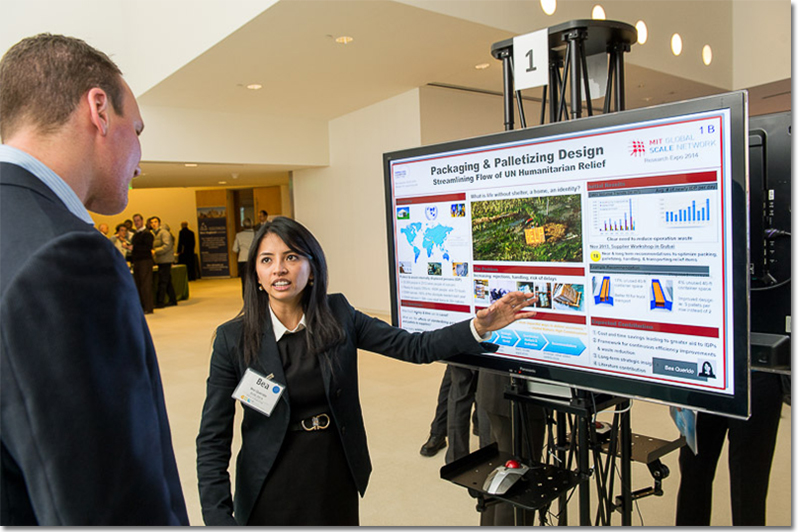Talent is the Future of Supply Chain Management
At MIT’s Research Expo 2014, the future of supply chain was on display.
You would think that issues like cost reductions, customer service levels and fuel prices would top the list of things that keeps distribution, transportation and supply chain managers up at night. After all, those are the items by which we are most often measured when bonuses are handed out.
But at every industry conference I have attended in the last year, the paucity of talent has been topic number one. That was true at ProMat last January, at the MHI fall meeting, and at the APICS and CSCMP annual conferences.
It could explain why supply chain management is the hot new MBA, according to the Wall Street Journal, or why it was the leading topic of discussion at all four of the Material Handling & U.S. Logistics Roadmap round table meetings last summer.
I just published a provocative piece out of Penn State on the coming supply chain talent perfect storm in the January issue of Supply Chain Management Review.
Related: Forecasting a Supply Chain Talent “Perfect Storm”
At the same time, there is a generation of young, dedicated professionals training for roles in our industry in colleges and universities around the country. Last night, I got a glimpse into the up and comers at MIT’s Research Expo 2014.
Part of the program included fast and furious presentations from faculty members such as Yossi Sheffi, Bruce Arntzen, Jim Rice and Chris Caplice. They provided concise overviews of research they’re conducting around topics such as visualizing supply chain flows, the role of logistics clusters as economic engines and demystifying supply chain innovation.
But the real stars were the students and the projects they are working on for corporate sponsors such as Boeing, Proctor & Gamble, Niagara Bottling and Ralph Lauren. Nearly 90 projects were on display. They were a window into both the kinds of issues that corporate America is grappling with as well as the ingenuity of the students tackling these problems. They ran the gamut from the esoteric to the prosaic. As one MIT dean put it, they’re not solving the flashiest problems, but they are tackling some of the biggest problems. So, what did I see?
First, there are problems that have plagued our industry inside and outside the four walls of the distribution center for years and will probably continue to plague us for years to come. For example, a student from Ecuador displayed a network design project he completed for Kentucky Fried Chicken, recommending that the Colonel expand from two to three distribution centers in that country. The annual savings were less than $50,000 a year in cost reductions. However, the third DC allowed for faster time to market, fresher food and improved customer service in areas in Southeastern Ecuador where KFC wanted to expand its presence.
Related: Network and Inventory Optimization for More Efficient Supply Chains
A student from Brazil satisfied my obsession with pallets through his project to improve warehouse processes for AmBev. The culprits in the warehouse that led to slowdowns on the production line will sound familiar to North American readers – non-productive lift truck operators and broken wooden pallets. Among his recommendations – switch to a plastic pallet. Who’d think I’d go to MIT to learn about pallets.

Bea Querido, master’s student in the MIT Zaragoza Logistics and Supply Chain Management Program (ZLOG), presents her project on streamlining packaging design and palletizing for humanitarian logistics. Bea won best poster for the ZLOG program.
I also met with two students in the early stages of a project on mitigating risk and improving resiliency in the supply chain of a high fashion retailer. They are trying to identify what happens if a supplier fails to ship or a distribution facility is shut down and how quickly can the retailer bounce back from those kinds of events.
Related: The Importance of a Thorough, Well-Managed Supply Chain Risk Strategy
Another student was working on an investigation into 3D printing for a supplier to big box retailers who wants to quickly and inexpensively create production molds to prototype new products. Right now, that supplier just shows its customers concept drawings of what’s on the drawing board because prototyping is so expensive. 3D printing could allow it to create actual prototypes in a cost effective way.
Related: Supply Chains and Third-Party Logistics Make Room for 3D Printing
What struck me most wasn’t how bright these students were. You expect that at MIT. Rather, it was how enthusiastic they were about an industry that young people once shunned in favor of finance and business management. Let’s hope it’s an indicator of the health of the industry going forward.













